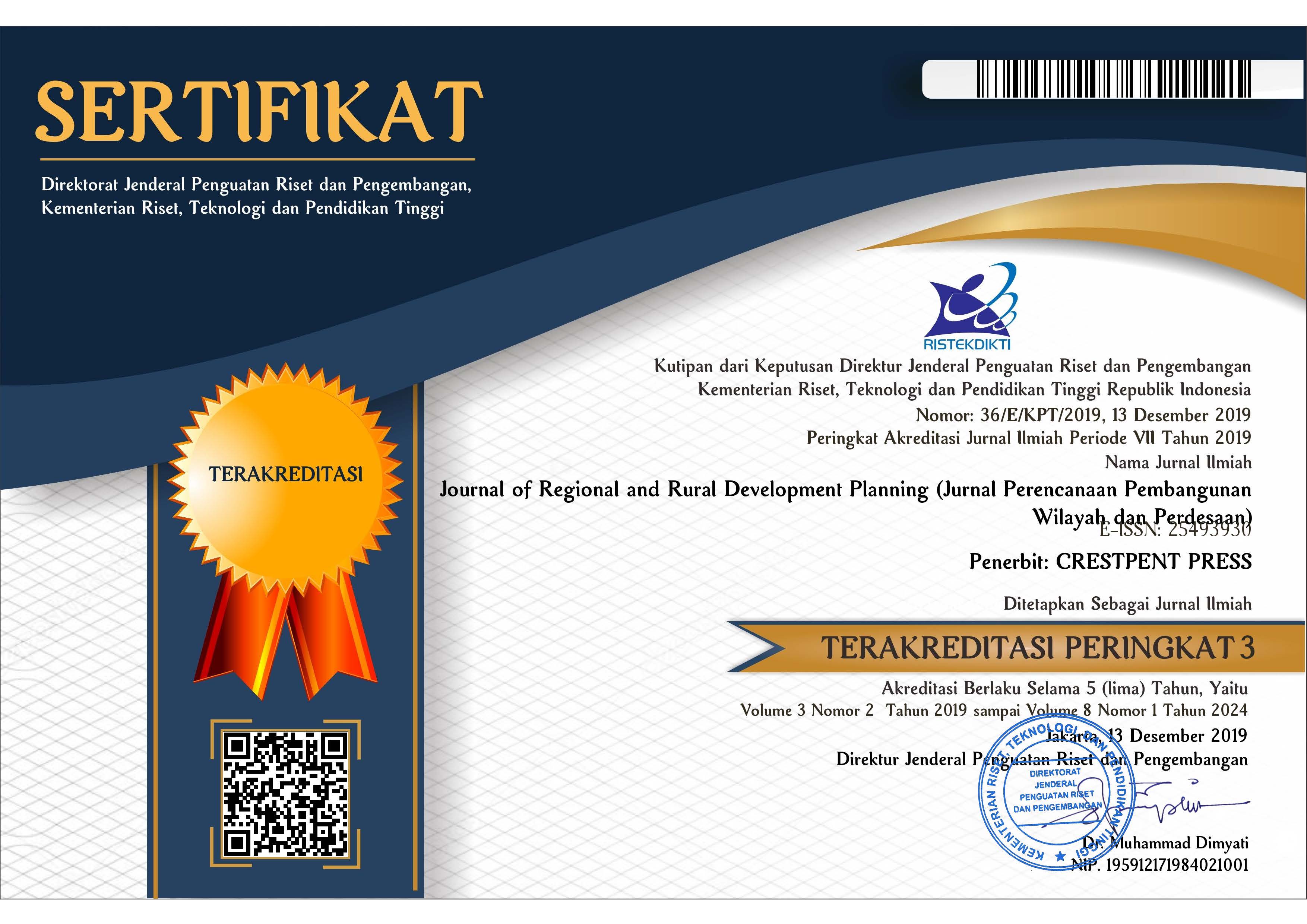Identifikasi Karakteristik Lahan Pemakaman TPBU di Kota Tangerang Selatan
Abstract
Cemetery is one of the space requirements that also needs to be considered in urban management. Because apart from burial activities, burial grounds can also function as urban green open spaces. Private Cemetery Parks (TPBU) currently have not received the attention of stakeholders, especially in urban areas. As a result, many TPBUs are not well organized in terms of management, location, and access to available facilities. South Tangerang City has approximately 150 TPBU whose ownership and management are carried out by social/community institutions. The purpose of this study is to identify the characteristics of private cemetery (TPBU) including management, location, land use, road network, funeral service coverage, funeral facilities, and infrastructure. The research method used is data collection through observation and interviews with grave managers. After that, descriptive analysis was carried out on several criteria, namely location and accessibility, status, and management of the cemetry, and available facilities. The results of this study also explore strategies for TPBU funeral management including the management system, as well as infrastructure that needs to be considered in the management of TPBU funerals in South Tangerang City.
References
Al-Akl, N. M., Karaan, E. N., Al-Zein, M. S., & Assaad, S. (2018). The landscape of urban cemeteries in Beirut: Perceptions and preferences. Urban Forestry & Urban Greening, 33, 66-74. doi:https://doi.org/10.1016/j.ufug.2018.04.011
Amalia, G., & Marwasta, D. (2016). Ketersediaan Lahan Tempat Pemakaman Umum (Tpu) di Kota Surakarta. Jurnal Bumi Indonesia, 5(4).
Anshori, M. S. (2018). Penentuan Lokasi Makam Umum di Kota Kediri. Jurnal Teknik ITS, 7(1), C28-C32.
Bennett, G., & Davies, P. J. (2015). Urban cemetery planning and the conflicting role of local and regional interests. Land Use Policy, 42, 450-459. doi:https://doi.org/10.1016/j.landusepol.2014.08.011
Čanády, A., & Mošanský, L. (2017). Public Cemetery as a biodiversity hotspot for birds and mammals in the urban environment of Kosice city (Slovakia). Zoology and Ecology, 27(3-4), 185-195. doi:10.1080/21658005.2017.1366024
Farhan, N. (2016). Estimasi Kebutuhan Lahan Pemakaman Di Kota Banda Aceh. Jurnal Ilmiah Mahasiswa Ekonomi Pembangunan, 1(1), 152-157.
Inayati, S. (2015). Aplikasi Sistem Perencanaan Taman Dan Jalur Hijau Pada Dinas Pertamanan Dan Pemakaman Provinsi Dki Jakarta. Universitas Pembangunan Nasional Veteran Jakarta,
Kartini, K., AS, N. S., & Surur, F. (2018). Analisis Ambang Batas Lahan Pemakaman di Kota Makassar. Universitas Islam Negeri Alauddin Makassar
Kowarik, I., Buchholz, S., von der Lippe, M., & Seitz, B. (2016). Biodiversity functions of urban cemeteries: Evidence from one of the largest Jewish cemeteries in Europe. Urban Forestry & Urban Greening, 19, 68-78. doi:https://doi.org/10.1016/j.ufug.2016.06.023
Lai, K. Y., Scott, I., & Sun, Z. (2019). Everyday Use of the City Cemetery: A Study of Environmental Qualities and Perceived Restorativeness in a Scottish Context. 3(3), 72.
Neckel, A., Korcelski, C., Kujawa, H. A., Schaefer da Silva, I., Prezoto, F., Walker Amorin, A. L., . . . Silva, L. F. O. (2021). Hazardous elements in the soil of urban cemeteries; constructive solutions aimed at sustainability. Chemosphere, 262, 128248. doi:https://doi.org/10.1016/j.chemosphere.2020.128248
Nguyen, T., & Nguyen, L. (2018). Groundwater pollution by longstanding cemetery and solutions for urban cemetery planning in Ho Chi Minh City – from reality to solutions. MATEC Web Conf., 193, 02008.
Nordh, H., Evensen, K. H., & Skår, M. (2017). A peaceful place in the city—A qualitative study of restorative components of the cemetery. Landscape and Urban Planning, 167, 108-117. doi:https://doi.org/10.1016/j.landurbplan.2017.06.004
Purwaningsih, F. (2009). Perencanaan Dan Perancangan Arsitektur Memorial Park & Funeral Homes Di Mojosongo Surakarta. Universitas Muhammadiyah Surakarta,
Quinton, J. M., Östberg, J., & Duinker, P. N. (2020). The influence of cemetery governance on tree management in urban cemeteries: A case study of Halifax, Canada and Malmö, Sweden. Landscape and Urban Planning, 194, 103699. doi:https://doi.org/10.1016/j.landurbplan.2019.103699
Song, S. (2017). Architecture of afterlife: Future cemetery in metropolis. University of Hawai'i at Manoa,
Sudiro, D. (2020). Analisis Ketersediaan Lahan Untuk Tempat Pemakaman Umum (Studi Kasus Tempat Pemakaman Umum Semper, Kelurahan Semper Timur, Kecamatan Cilincing, Kota Administrasi Jakarta Utara). Jurnal Geografi Geografi dan Pengajarannya, 18(2), 105-118.
Swensen, G., & Skår, M. (2019). Urban cemeteries’ potential as sites for cultural encounters. Mortality, 24(3), 333-356. doi:10.1080/13576275.2018.1461818
Wulandari, A. (2014). Kajian Potensi Pemakaman Sebagai Ruang Terbuka Hijau Perkotaan, Studi Kasus: Tpu Kota Pontianak. Langkau Betang: Jurnal Arsitektur, 1(2), 54-64. doi:http://dx.doi.org/10.26418/lantang.v1i2.18800
Yılmaz, H., Kuşak, B., & Akkemik, Ü. (2018). The role of Aşiyan Cemetery (İstanbul) as a green urban space from an ecological perspective and its importance in urban plant diversity. Urban Forestry & Urban Greening, 33, 92-98. doi:https://doi.org/10.1016/j.ufug.2017.10.011
Copyright (c) 2022 Journal of Regional and Rural Development Planning (Jurnal Perencanaan Pembangunan Wilayah dan Perdesaan)

This work is licensed under a Creative Commons Attribution-ShareAlike 4.0 International License.




.png)














